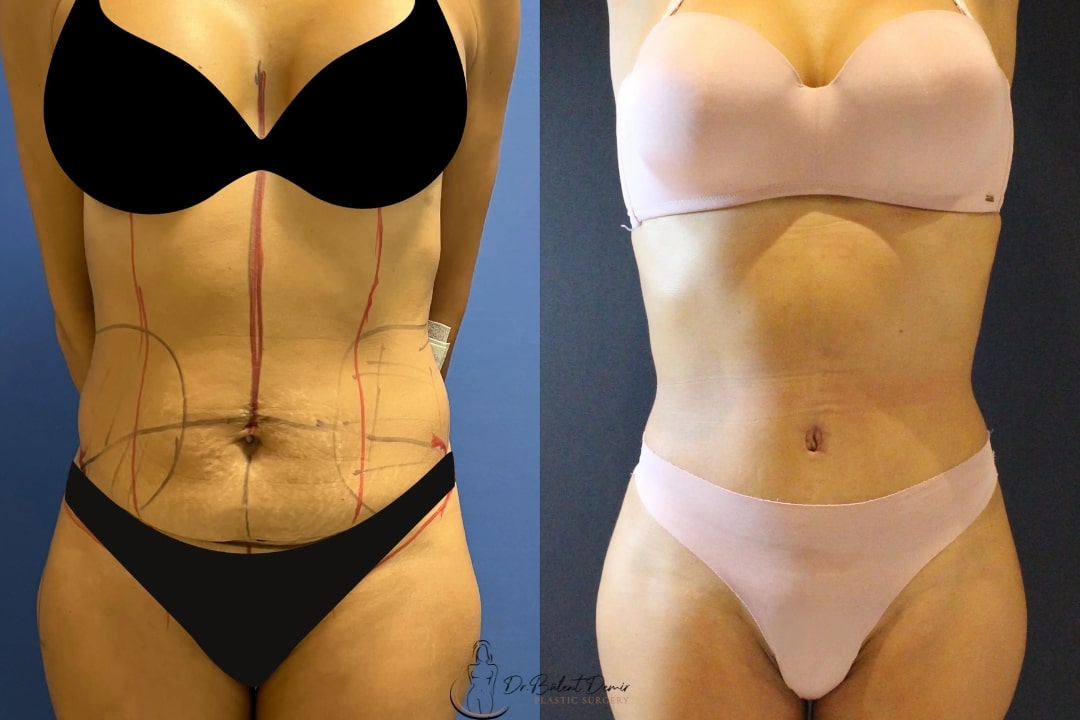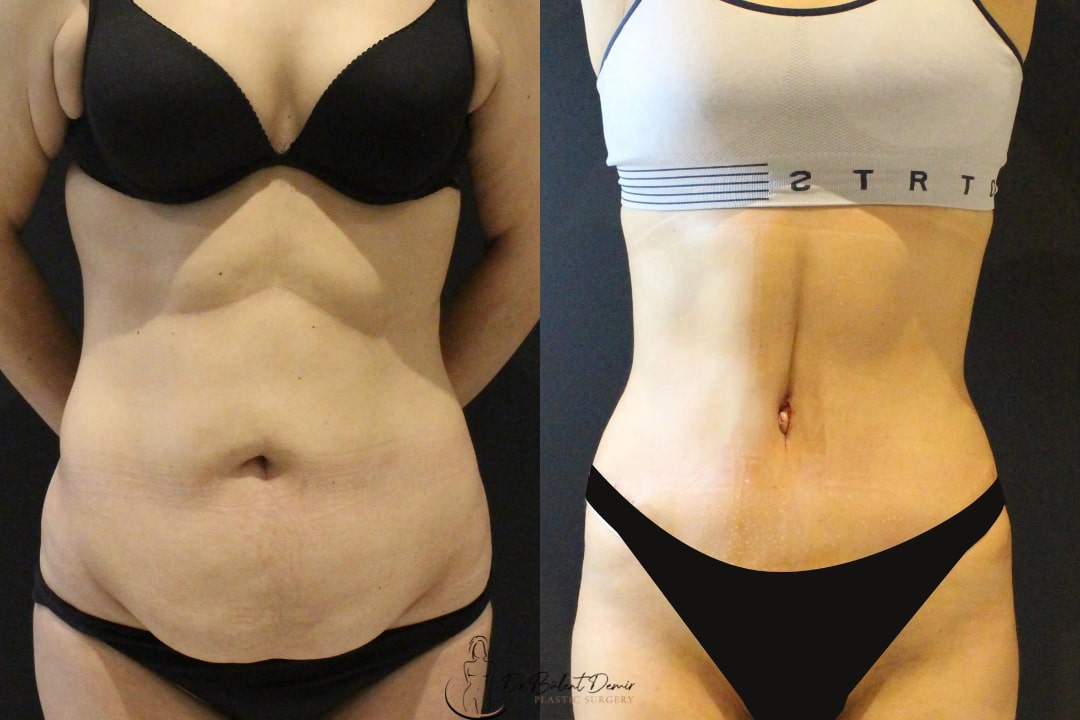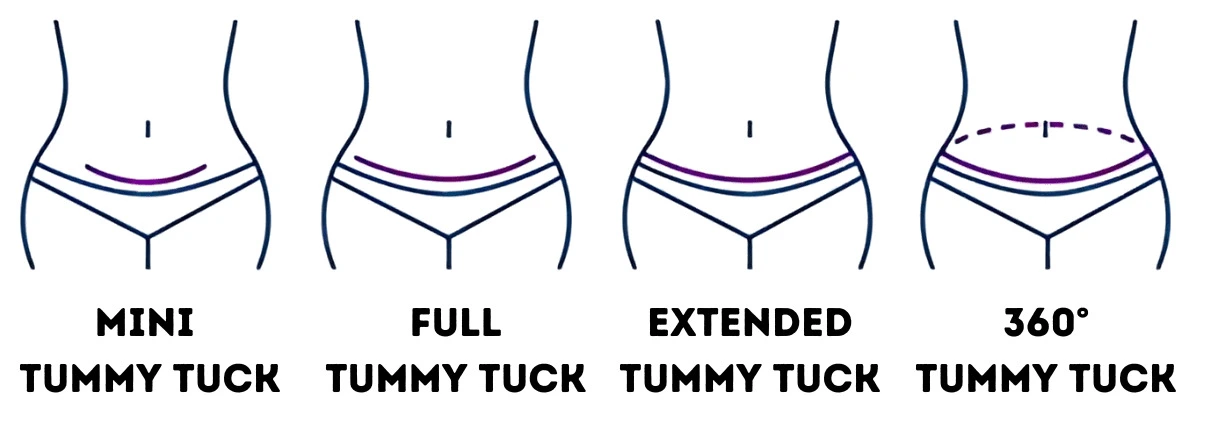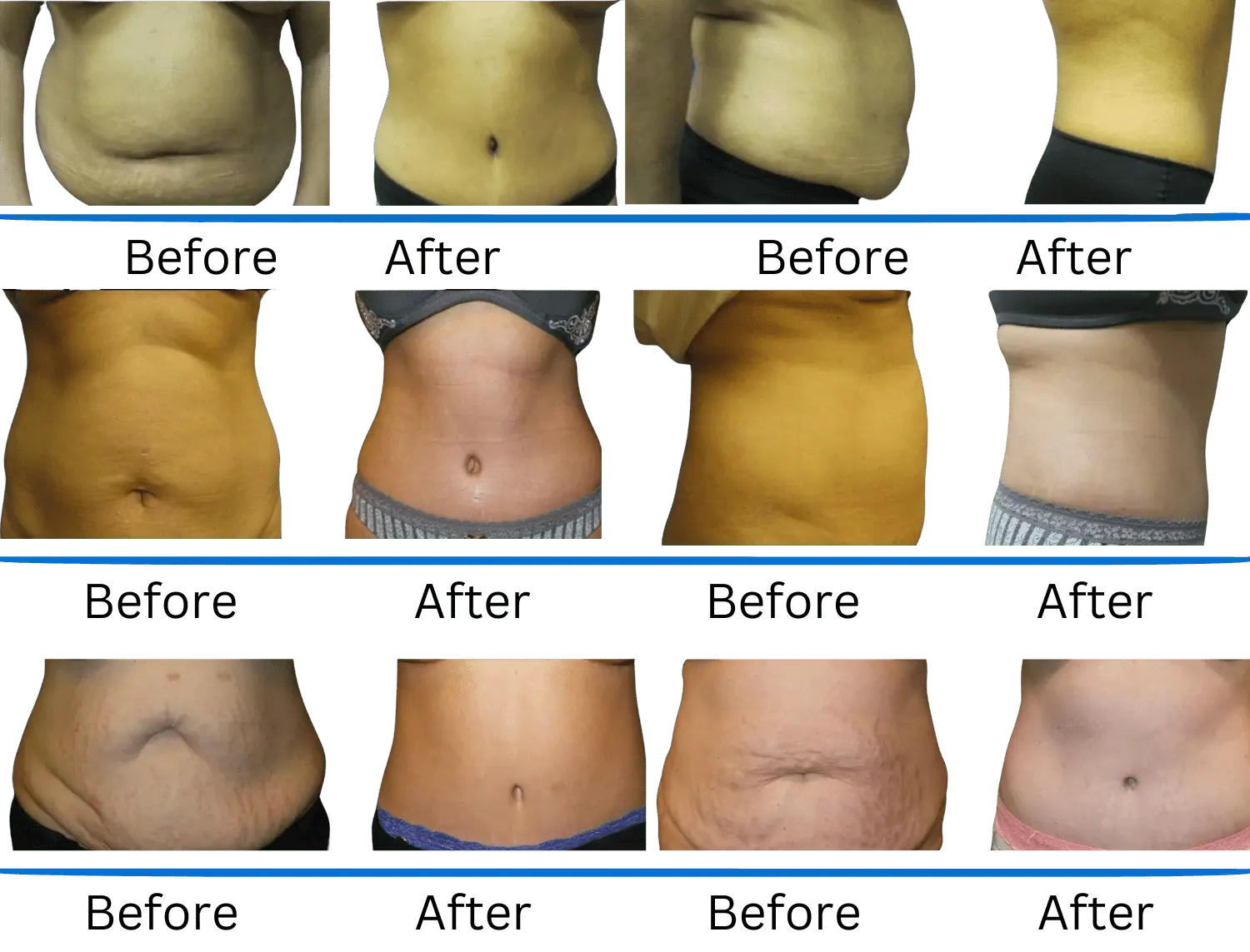Imagine a world where you look in the mirror and see the best version of yourself—sleek, refined, and confidently radiant. The 360 Tummy Tuck isn't just a procedure; it's a complete transformation. A procedure for those who refuse to surrender to excess body weight, this advanced, full-body contouring experience redefines your waistline, smooths excess skin, and tightens your core from every angle—because beauty isn’t one-dimensional. Whether reclaiming your body after weight loss or redefining your silhouette, this is the moment where confidence meets inspiration.

Because you deserve more than just a change—you deserve a revolution. Welcome to the future of body contouring. Welcome to you, reimagined.
What is 360 tummy tuck?
A 360 tummy tuck, also called a circumferential abdominoplasty or belt lipectomy, is not a weight-loss surgery but a body contouring procedure to reshape the entire midsection, remove excess skin and fat. Unlike a traditional tummy tuck, which focuses only on the front of the abdomen, this advanced technique targets the abdomen, waist, flanks, lower back, and hips for a more balanced, natural-looking silhouette.
The procedure involves a circumferential incision around the midsection, allowing surgeons to remove excess fat and sagging skin while tightening the abdominal muscles for a firmer core. Liposuction is often used to enhance the results by sculpting the waistline and eliminating stubborn fat deposits. The remaining skin is then carefully repositioned to create a smoother, more toned appearance.
Benefits of 360 tummy tuck procedure
A 360 Tummy Tuck offers several benefits, including improved muscle tone, a slimmer waistline, and the reduction of unwanted bulges and love handles. It’s an ideal choice for individuals who have experienced significant weight loss or struggle with loose skin around their entire midsection.
Physical benefits
- Full midsection contouring: Removes hanging skin and excess fat from the abdomen, waist, hips, and back for a balanced, toned appearance.
- Core muscle tightening: Strengthens and repairs abdominal muscles, improving posture and potentially reducing back pain.
- Fat elimination: Liposuction targets stubborn fat, smoothing areas like flanks, bra rolls, and lower back.
- Excess skin removal: Ideal for those post-weight loss or pregnancy, creating a firmer, smoother look.
Aesthetic benefits

- Harmonized body shape: Unlike standard tummy tucks, the 360 approach ensures uniform contouring from all angles.
- Enhanced proportions: A more balanced silhouette, emphasizing natural body curves.
- Reduced stretch marks: Fat reduction often minimizes deep folds and visible stretch marks.
Health & wellness benefits
- Better posture & mobility: A stronger core enhances mobility, making exercise and daily activities more comfortable and effortless.
- Relief from skin irritation: Eliminates discomfort caused by overhanging skin.
- Increased confidence: A transformed body can lead to higher self-esteem and a more positive self-image.
Who is the ideal candidate for 360 tummy tuck?
The best candidates for a 360 Tummy Tuck are individuals who:
- Individuals with a body mass index of 30 or less are generally considered good candidates for a 360 Tummy Tuck. The risk of complications rises as BMI increases.
- Have loose skin and excess fat around the abdomen, hips, and back.
- Want a firmer, more sculpted midsection.
- Experience weakened abdominal muscles due to pregnancy, weight changes, or aging.
- Have reached and maintained a stable weight.
- Are in good overall health.
- Have lost a significant amount of weight, leading to sagging skin.
- Are near their ideal body weight.
- Possess good skin elasticity.
- Have kept their weight steady for at least six months.
- Do not smoke and are in strong physical condition.
Candidates should also be dedicated to maintaining their post-surgery weight through a healthy lifestyle, including proper nutrition and regular exercise. While a high BMI doesn’t automatically disqualify someone, overall health is a key consideration. This procedure is suitable for both men and women seeking a comprehensive body contouring solution.
What does 360 tummy tuck involve?
A 360 tummy tuck procedure typically takes 4 to 8 hours, depending on the complexity of the case.
Step-by-step breakdown of the procedure
- Anesthesia: The surgery is performed under general anesthesia to ensure comfort and pain control throughout the procedure.
- Strategic incisions: A horizontal incision is carefully placed from hip to hip along the lower abdomen, typically low enough to be concealed by underwear. Additional incisions around the sides and back allow for full 360-degree contouring.
- Liposuction for precision: Using advanced liposuction techniques, the surgeon removes stubborn fat deposits from the abdomen, flanks, back, and sometimes thighs for a smoother, more defined appearance.
- Muscle repair for a stronger core: If the abdominal muscles are weakened or separated (a condition known as diastasis recti), they are carefully sutured back together to restore core strength and create a firmer, flatter stomach.
- Removing excess skin: Loose, sagging skin is surgically removed from the front, sides, and back, eliminating folds and improving overall skin tightness.
- Smoothing and tightening: The remaining skin is gently placed over the newly sculpted body to ensure a natural, contoured look.
- Repositioning the belly button: Since excess skin is removed, the surgeon creates a new opening for the belly button and carefully sutures it into its natural-looking position.
- Closing the incisions: The incisions are meticulously closed using sutures, surgical adhesives, or medical tape to promote optimal healing.
What is recovery like after the 360 tummy tuck in Antalya?
Most patients may stay in the hospital for 2 to 4 days for close monitoring and post-operative care, but this duration can change according to special needs and the healing process of each individual patient. While recovery requires patience, the results are remarkably transformative, offering a firmer, smoother, and more sculpted waistline—a dramatic improvement compared to a standard tummy tuck.
Week 1 (Days 2-7): Rest and initial healing
The first week is focused on rest and recovery. Physical activity is limited, and patients should take time off work. Drains may be placed to remove excess fluid and are typically removed within 3-7 days. Compression garments help minimize swelling. Light walking is encouraged to promote circulation, but fatigue and tenderness are expected.
Week 2 (Days 8-14): Gradual return to routine
By the second week, most patients feel noticeably better. Many are ready to return to work by the end of the week. However, it is crucial to resume activities gradually to avoid complications. The compression garment should still be worn to support healing and maintain results.
Week 3 (Days 15-21): Increased comfort
Most patients are back to work and feel much improved. Prescription pain medication is usually no longer needed, though mild discomfort may persist. Compression garments are still recommended for optimal results.
Week 4 and beyond: Returning to normal
By this stage, patients see a flatter abdomen and can resume light exercise. Strenuous workouts, especially abdominal exercises, should wait 6-8 weeks. Scars may still be prominent but will gradually fade.
How much is 360 tummy tuck in Turkey?
In 2024, a tummy tuck in Turkey will typically cost between $2,000 and $8,000. Prices fluctuate based on the surgery's complexity and the clinic's location. The final expense is determined by surgical fees, anesthesia, hospital charges, and the surgeon's expertise, which can vary significantly between different medical facilities.
A tummy tuck in Turkey is more affordable because of lower costs for the operating room, medical supplies, and surgeon’s fees. Additionally, favorable exchange rates make this procedure more accessible to international patients, allowing them to undergo surgery at a significantly reduced price compared to other countries.
For more information about surgery packages, please contact our Dr. Bülent Demir aesthetic clinic in Antalya.
Tummy tuck vs 360 tummy tuck: What are the differences?
While both procedures aim to enhance the abdominal area, a 360 Tummy Tuck offers a full-body approach to midsection sculpting, delivering more comprehensive and striking results.

Scope of treatment
- Tummy tuck: Focuses on the front of the abdomen.
- 360 tummy tuck: Targets the entire midsection, including the abdomen, flanks, and lower back for a more complete transformation.
Incisions & procedure
- Tummy tuck: Involves a horizontal incision from hip to hip along the lower abdomen. May include an additional incision around the navel to adjust excess skin.
- 360 tummy tuck: Requires an incision that encircles the entire waistline. Often includes advanced liposuction techniques for more thorough fat removal.
Treatment areas
- Tummy tuck: Primarily removes excess skin and fat below the belly button.
- 360 tummy tuck: Reshapes the entire torso, including flanks, back, and bra rolls for a balanced contour.
Muscle repair
- Both procedures can include abdominal muscle tightening, but a 360 Tummy Tuck may offer a more extensive core repair.
Recovery time
- A 360 tummy tuck typically involves a longer recovery due to its more comprehensive nature.
Ideal candidates
- Tummy tuck: Best for those with loose skin and fat mainly in the lower abdomen.
- 360 tummy tuck: Ideal for patients with excess skin or fat around the entire lower torso, often after major weight loss.
360 tummy tuck before and after in Turkey

Frequently Asked Questions
What BMI do you need to be for a 360 tummy tuck?
A body mass index (BMI) of 30 or less generally indicates suitability for a 360 Tummy Tuck in Turkey. As BMI rises, the likelihood of complications increases. Specifically, higher BMIs correlate with a greater risk of fluid accumulation (seromas), wound infections, wound separation (dehiscence), suboptimal scarring, blood clots, and patient dissatisfaction.
Is 360 tummy tuck considered a safe procedure?
A 360 tummy tuck is generally safe when performed by a skilled plastic surgeon, though it carries some risks like any surgery. The procedure has a strong safety record, but factors such as health, medical history, and lifestyle can influence complication risks. Minor concerns include infection, scarring, and fluid buildup (seroma), while rare but serious risks include anesthesia complications and deep vein thrombosis
Choosing an experienced surgeon and following post-operative care instructions can help minimize these risks and ensure a smoother recovery.
Will the fat return after 360 tummy tuck?
A 360 tummy tuck permanently removes fat cells from the treated areas, meaning they won’t return. However, this doesn’t prevent future weight gain in untreated areas. Many patients enjoy long-lasting results, with some studies showing sustained weight loss for 10 to 15 years or more.
The longevity of the results depends on lifestyle choices after surgery. To preserve the new contours, patients should follow a balanced diet, engage in regular exercise, and maintain a stable weight. Committing to these habits helps prevent fat accumulation elsewhere and ensures the best long-term outcome from the procedure.
Should I opt for a full or 360 tummy tuck?
If your main concern is loose skin and excess fat on the front of your abdomen, a traditional tummy tuck may be all you need to achieve a tight and more toned look. However, if you’re looking to reshape your entire midsection —including love handles and back fat— a 360 Tummy tuck might be the better option for a full-body transformation.
The ideal choice depends on your body type, goals, and specific concerns. A consultation with your plastic surgeon is essential to determine which procedure will deliver the best, most natural-looking results for you.
Can an overweight person have 360 tummy tuck?
Yes, a tummy tuck is possible for overweight individuals, but surgeons typically recommend a BMI below 30 for the best results and lower risk of complications. Carrying extra weight can increase the chances of healing issues, blood clots, and deep vein thrombosis (DVT).
For patients with a higher BMI, some surgeons use specialized techniques like "plus-size abdominoplasty" or "high BMI abdominoplasty" to accommodate their unique needs.
What is the ideal age for 360 tummy tuck?
There is no ideal age for a 360 tummy tuck, as it can be performed on adults of various ages. Most patients choose to undergo the procedure in their 30s to 50s, but eligibility depends more on health and skin elasticity than age.
In some countries, the minimum age is 18, ensuring the body has fully developed. While there’s no strict upper age limit, candidates should be in good overall health for a safe procedure and smooth recovery. A consultation with a plastic surgeon can help determine if a tummy tuck is right for you.
Does 360 tummy tuck provide a lift to your thighs?
A 360 tummy tuck can slightly enhance the upper thighs, especially the outer thighs, but it is not a thigh lift. Since the procedure removes excess skin and fat around the lower torso, it may provide some indirect improvement to the thigh area, but its primary focus is on contouring the midsection.
Can 360 tummy tuck improve the appearance of your pubic area?
Yes, a 360 tummy tuck can help improve the appearance of the pubic region by removing excess skin and fat from the lower abdomen, which may reduce sagging in this area. However, the level of improvement depends on individual anatomy and the surgical techniques used. In some cases, patients may need a mons lift for more refined results and better contouring of the pubic area.
Why do you need 360 tummy tuck?
A 360 tummy tuck is ideal for those seeking full-body contouring. It sculpts the waist, hips, abdomen, and back, creating a balanced, toned look. The procedure removes excess skin and fat from the entire midsection, making it beneficial for those with loose skin after weight loss or pregnancy. It also tightens abdominal muscles, improving core strength and posture. Beyond aesthetics, it may offer health benefits, such as reduced back pain. For the best results, consult a plastic surgeon to determine if this comprehensive body transformation is right for you.
Can your stomach get big again after 360 tummy tuck?
While a 360 tummy tuck delivers enduring outcomes, it's possible for your abdomen to accumulate fat again. The fat cells extracted during the procedure are permanently eliminated and do not regenerate. However, significant weight gain can stimulate the development of new fat cells, potentially affecting both treated and untreated areas.
What is the difference between an extended tummy tuck and a 360 tummy tuck?
The key distinction lies in the treatment area: extended tummy tucks focus on the abdomen and flanks, while 360 tummy tucks address the entire torso. This results in a longer incision for the 360 procedure, and a more comprehensive contouring, often involving circumferential liposuction, for a more dramatic, all-around result.
Can smoking have an impact on my 360 tummy tuck?
Smoking poses serious risks to a 360 tummy tuck. It hampers wound healing by limiting blood flow, increasing infection and tissue death risks. Nicotine constricts vessels, hindering proper blood supply crucial for this procedure. Poor scarring and extended recovery are common. Smokers often need more anesthesia and pain medication.
Quitting well before surgery and throughout recovery is vital. Even one cigarette can compromise results. To ensure optimal healing and minimize complications, abstaining from smoking is strongly advised. This significantly improves the likelihood of a successful outcome and reduces potential post-surgical issues.
How much skin will be removed during 360 tummy tuck?
The exact amount varies based on individual factors like body type and goals. Often combined with liposuction, the procedure aims for comprehensive contouring. Success is measured by a harmonious appearance, not just skin quantity. Consultation with a qualified surgeon is crucial to determine personalized expectations and surgical plans.
How long should a compression garment be worn after a 360 degree tummy tuck?
After the 360 tummy tuck, compression garment use is vital for 6-8 weeks, varying by individual healing. Initially, wear it constantly for 4-6 weeks, removing it only for bathing. Weeks 6-8 may allow reduced wear, as directed. Some may require longer usage.
Does a 360 tummy tuck result in a flat stomach?
Flatness varies by individual factors like body shape and visceral fat. Realistic expectations are key; a perfectly flat stomach isn't always guaranteed. Maintaining results requires stable weight and adherence to a healthy lifestyle.
How many sizes will you lose with a 360 tummy tuck?
A 360 tummy tuck is primarily a body contouring procedure rather than a weight loss method. While it can eliminate around 10 pounds of fat and reduce several inches from the midsection, its main goal is to enhance body shape and definition. Many patients experience a noticeably slimmer silhouette, with some reports indicating a reduction of 1 to 3 dress or pant sizes at the waist.
What are the chances of complications with a 360 tummy tuck?
A 360 tummy tuck has a higher complication rate than other cosmetic procedures, though the overall risk remains low. Major complications occur under 5% of patients. The most frequent minor complications include: Hematoma, infection, blood clots, seroma, wound healing issues.
What should you know before getting a 360 tummy tuck?
A 360 tummy tuck combines a traditional tummy tuck with circumferential liposuction to reshape the entire midsection. It tightens muscles, removes excess skin, and contours the front, back, and sides. Preparation includes maintaining a healthy diet, arranging post-surgery help, and quitting smoking.
Recovery takes 3-6 months, with most returning to work in 7-10 days and avoiding strenuous activity for 4-6 weeks. Risks include infection, bleeding, blood clots, numbness, and asymmetry. Scarring fades over time, but pregnancy may affect results. Maintaining a stable weight is key for long-term benefits. Understanding these factors ensures better preparation and recovery.
How long does a 360 tummy tuck take?
The surgery typically takes 5 to 6 hours, though the duration can vary. Factors influencing the length include the patient’s anatomy, the volume of skin and fat removal, the degree of muscle tightening needed, and the surgeon’s skill and approach.
How painful is a 360 degree tummy tuck?
A 360-degree tummy tuck is painless during surgery due to general anesthesia. However, post-surgical discomfort is typically greater than a standard tummy tuck because of its extensive nature. Pain is most intense in the first few days and gradually improves over time. Patients may experience significant soreness, bruising, and tenderness across the entire midsection, including the front, back, and sides, especially in the first week.
What are the consequences of not wearing a compression garment after a 360 degree tummy tuck?
Not wearing a compression garment after a 360-degree tummy tuck can negatively impact recovery and final results. Potential issues include:
- Increased swelling due to lack of controlled pressure.
- Slower healing as circulation is not optimized.
- Higher risk of complications, including blood clots and seroma.
- Suboptimal results, with tissues not settling properly.
- Poor scar management, leading to more visible scars.
- Compromised skin tightening, reducing the effectiveness of the procedure.
What do the scars look like after a 360 degree tummy tuck?
Scars from a 360-degree Tummy Tuck are more extensive than a standard tummy tuck due to the procedure’s scope. The main scar runs around the waistline, typically low enough to be hidden by clothing, while a small navel scar may form if repositioning is needed.
Initially pink and thin, scars darken around one month, then gradually lighten over 6-12 months. By 1-2 years, they fade significantly. Healing varies by individual, and some may develop raised scars requiring treatment. Proper post-surgical care helps minimize scarring and improve long-term appearance.
Can you have children after a 360 degree tummy tuck?
You can have children after a 360-degree Tummy Tuck, as it does not affect fertility or pregnancy. However, surgeons advise waiting 6-12 months post-surgery for full healing. While pregnancy remains safe, some women may feel increased abdominal tightness as their belly expands.
Pregnancy can alter results by stretching muscles and skin, potentially causing loose skin, diastasis recti, or new stretch marks. Many opt for revision surgery after childbirth. For the best, lasting results, surgeons often recommend having a tummy tuck only after completing your family. Discussing future pregnancy plans with your surgeon is essential before the procedure.
What happens if you gain weight after a 360 degree tummy tuck?
Weight gain can impact tummy tuck results, depending on the amount:
- Small fluctuations (2-6 kg): Usually don't significantly affect results.
- Moderate gain (6-10 kg): May stretch the skin and muscles, causing a slight belly bulge.
- Significant gain (10+ kg): Can loosen skin, separate muscles, add fat deposits, and create stretch marks, altering body contour.
Substantial weight gain may require revision surgery, which is more complex. A tummy tuck isn’t a weight-loss solution, so maintaining results requires a healthy diet and regular exercise.
What is the difference between a 360 degree tummy tuck and a lower body tuck?
A 360-degree tummy tuck and a lower body lift are similar procedures but differ in scope and complexity. A 360 Tummy Tuck primarily targets the midsection, including the abdomen, sides, and lower back, while a lower body lift is more extensive, also addressing the buttocks, outer thighs, and sometimes inner thighs. The incision for a tummy tuck typically runs around the waistline, whereas a lower body lift involves a larger, bikini-like incision.
Additionally, a lower body lift often includes a buttock lift, which a tummy tuck does not. Because a lower body lift treats a larger area, it is generally a more complex procedure with a longer recovery period. While both surgeries improve body contour, a lower body lift provides more comprehensive reshaping than a 360-degree tummy tuck.
Is it possible to have more than one 360 degree tummy tuck?
While having multiple 360-degree Tummy Tucks is possible, it is rarely recommended. The procedure is already extensive, reshaping the abdomen, flanks, and lower back, leaving little need for repetition. Additional surgeries can lead to excessive scar tissue, reduced skin elasticity, and increased complication risks. Instead, patients dissatisfied with results may consider revision surgery, alternative body contouring procedures, or non-surgical treatments for minor adjustments.
Are there alternatives to a 360 degree tummy tuck?
Several alternatives to a 360-degree tummy tuck provide body contouring with less invasive methods. Minimally invasive options include a mini tummy tuck for lower abdominal tightening and liposuction or Vaser liposuction for fat removal. Non-surgical treatments like CoolSculpting, EmSculpt, ThermiTight, and Ultherapy help reduce fat, tone muscles, or tighten skin.
Some patients opt for combination treatments like non-surgical BBL or AbEX for enhanced results. While these approaches offer shorter recovery and fewer risks, they may not match the transformative effects of a tummy tuck, making a consultation with a specialist essential.
